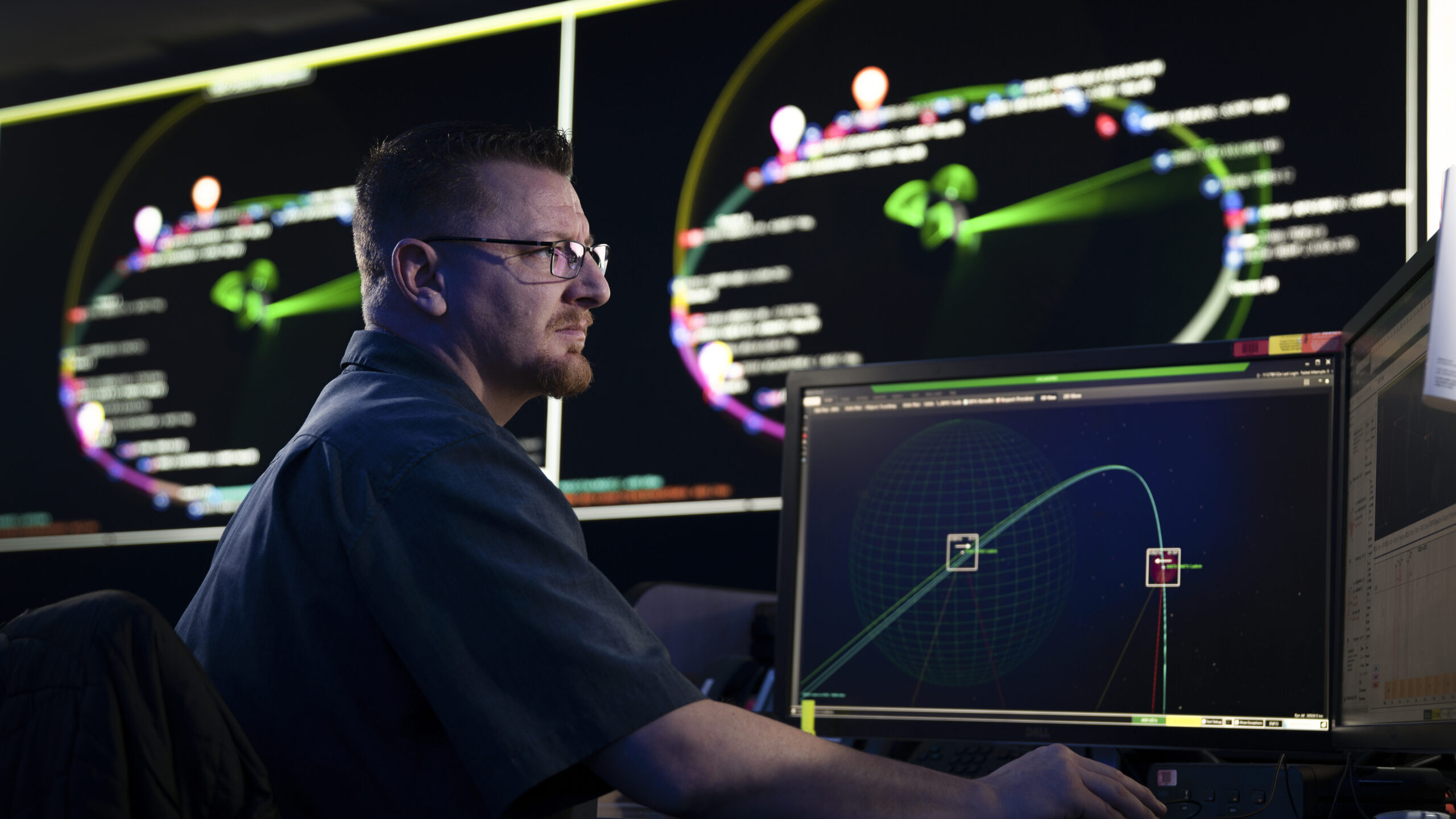
Edward Ramey, of the Joint Task Force-Space Defense, looks at a computer screen at Schriever Space Force Base, Colorado, Dec. 19, 2022. Through the partnering of the Department of Defense, Intelligence Community and National Reconnaissance Office in the National Space Defense Center, JTF-SD brings to bear the full force of the U.S. Government and synchronizes space superiority planning and operations. (U.S. Space Force photo by Tiana Williams)
GEOINT 2023 — The National Reconnaissance Office is asking commercial satellite firms to offer up new capabilities for remote sensing via electro-optical cameras, in an effort to keep up to date with emerging technology in a rapidly evolving field.
Pete Muend, the spy-sat agency’s director of commercial operations, told the audience at the US Geospatial Intelligence Foundation’s GEOINT 2023 conference that his office on Monday issued a new draft request for proposals (RFP) to suss out the current marketplace.
“Actually, it just was announced this morning, on the electro-optical side a draft RFP came out re-looking at that sector … to see where the industry is pushing us, what what else is out there and and where we can position [ourselves] on the government side to take better advantage of that,” he said.
NRO in May 2022 granted a first round of 10-year contracts worth $4 billion under the Strategic Commercial Enhancements Broad Agency Announcement (BAA) process, which allow the agency to quickly award contracts to commercial imagery providers. Those awards went to three US commercial remote sensing firms — Maxar Technologies, Planet and BlackSky — with whom NRO already had put under initial study contracts a year earlier.
Muend said that a formal RFP will be issued at the end of this fiscal year (that is, by end September) with an award shortly thereafter, to “see what other EO or closely related phenomenologies are out there.” He explained that the idea “is to really embrace, to get on contract some of these new entrants, other providers, other related phenomenology, still on the electro-optical side, but perhaps, in addition to standard panchromatic — some of the infrared imagery and non-Earth imagery, things along those lines and, and really seeing what mission utility is there for some of these other providers.”
Non-Earth imaging refers to using satellites to keep an eye on other satellites and dangerous space junk, a capability that has been in increasing demand as Russia and especially China build up their space capabilities, including systems that might be used to do harm to US satellites. The Government Accountability Office (GAO), in a report released in April, pushed the Space Force to move faster to integrate commercial such space domain awareness (SDA) capabilities in order to fill current blind spots — which “include gaps in the geographical distribution of global sensors that collect data and limited sensor capability for objects in deep space.”
Up to now, the SDA mission has been in the hands of US Space Command and the Space Force. SPACECOM operates a network of ground-based radar and telescopes, as well six Geosynchronous Space Situational Awareness Program (GSSAP) satellites. The Space Force, meanwhile, is charged with keeping the tech up-to-date and training operators to work those systems — and further has been contemplating how to efficiently acquire and ingest commercially-provided tracking data.
That said, NRO and the Space Force are collaborating on the development of a new satellite-to-satellite imaging constellation, called SILENTBARKER. NRO expects to launch the first prototype birds later this summer.
Further, the two sides have been circling around a tentative agreement on how to split responsibility for acquiring commercial imagery of all sorts, including that of other satellites. At the moment, however, those talks remain a work in progress. Thus, the NRO plan for a new buy of commercial imagery of other satellites could muddy the waters.
NRO Director Chris Scolese addressed the issue of commercial acquisition authority in a fireside chat here today, but his remarks, if anything, only further obscured the state of play.
“We have to recognize the Space Force also has authorities in different areas — space domain awareness is one that that’s not in the NRO’s job jar, if you will,” he said. “They’ll have some some roles to go off and acquire things, and we want to just go off and make sure that we can we can make that as broadly available as possible.”
At the same time, Scolese reiterated (twice) that NRO is officially mandated to acquire commercial imagery, whatever the phenomenology involved in gathering it.
“NRO does have the responsibility to go off and get the pixels and the RF [radio frequency data],” he said.
Meanwhile, commercial vendors already are venturing into the marketplace with space-based SDA products. For example, Maxar Technologies announced in December that it would deploy a non-Earth imaging capability this year, after obtaining a license from the National Oceanic and Atmospheric Administration. Australian firm HEO Robotics also is offering satellite-to-satellite imagery, boasting 38 sensors already on orbit.






















